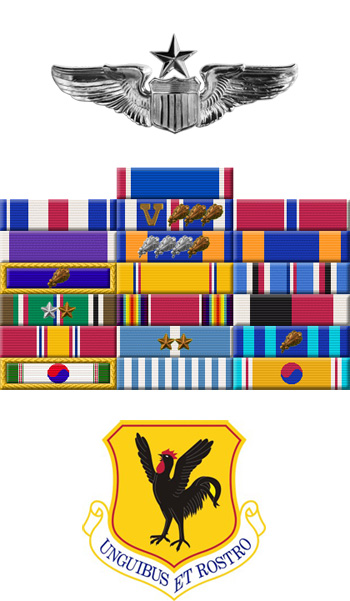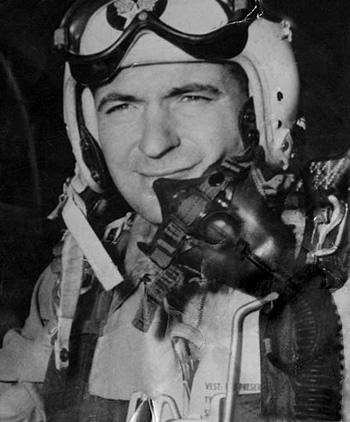Bill Halton was born on July 17, 1917, in Providence, Rhode Island. He enlisted in the Aviation Cadet Program of the U.S. Army Air Forces on August 18, 1941, and was commissioned a 2d Lt and awarded his pilot wings on March 7, 1942. After completing P-47 Thunderbolt training, he was assigned to the 328th Fighter Squadron of the 352nd Fighter Group in England in December 1943, and took command of the 487th Fighter Squadron, also in the 352nd Fighter Group, in November 1944, serving there until September 1945, when he became Commander of the 352nd Fighter Group. While flying with the 328th FS and the 487th FS, Col Halton was credited with the destruction of 10.5 enemy aircraft in aerial combat plus 2 more on the ground while strafing enemy airfields. He was released from active duty on March 26, 1946, but returned on July 5, 1946. He joined the 67th Fighter Bomber Squadron of the 18th Fighter Bomber Group in Korea, where he flew F-51 Mustangs until he was killed in action on May 21, 1952. Col Halton had accumulated 2,595 flying hours at the time of his death.
His Distinguished Service Cross Citation reads:
The President of the United States takes pride in presenting the Distinguished Service Cross (Posthumously) to William Timothy Halton, Colonel, U.S. Air Force, for extraordinary heroism in connection with military operations against an armed enemy of the United Nations while serving as Deputy Commander of the 18th Fighter-Bomber Wing, in action against enemy forces in the Republic of Korea on 6 April 1952. Upon completion of a normal tour with the 136th Fighter-Bomber Group, Colonel Halton was assigned as Deputy Commander of the 18th Fighter-Bomber Wing with specific instructions not to fly combat missions. Colonel Halton persisted in his desire to fly in combat, and made a special request to fly additional missions in order to improve the Group's combat effectiveness by his own example. Colonel Halton set such an example by masterfully demonstrating that F-51 type aircraft could successfully operate in jet combat zones without fighter-interceptor cover. He demonstrated great heroism and superior airmanship in leading his flight on a dive-bombing attack on rail lines near Sonchon, Korea. Even through being attacked by a MIG and intense ground fire, Colonel Halton completely disregarded personal safety, pressing a vicious attack on the rail lines. Although the flight was attacked by enemy jet aircraft and subjected to heavy ground fire, Colonel Halton's inspiring leadership was responsible for numerous rail outs by the four aircraft in his flight. Undaunted by the fact that the enemy was increasing his operations in that area, Colonel Halton then led a reconnaissance of the main supply route to Sinuiju. The result of this highly successful mission was measured by the boost in the morale of the pilots.
|



